

MnDNR Anticipated Calf Abandonments, Discussed w Zoo Before 2014 Collaring. By Javier Serna Assistant Editor Posted on July 21, 2014 Apple Valley, Minn. — Six moose calves that were abandoned by their mothers after Minnesota DNR researchers placed GPS collars on them are doing well at the Minnesota Zoo.
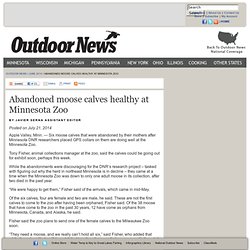
Tony Fisher, animal collections manager at the zoo, said the calves could be going out for exhibit soon, perhaps this week. While the abandonments were discouraging for the DNR’s research project – tasked with figuring out why the herd in northeast Minnesota is in decline – they came at a time when the Minnesota Zoo was down to only one adult moose in its collection, after two died in the past year. “We were happy to get them,” Fisher said of the arrivals, which came in mid-May.
Of the six calves, four are female and two are male, he said. Fisher said the zoo plans to send one of the female calves to the Milwaukee Zoo soon. “She is just too big,” Fisher said. “We took a week to think about it,” DelGiudice said. Of those seven calves, six were shipped to the zoo. Saving Minnesota’s Vanishing Moose. For the week of July 13th, 2014.

NH Moose Population Facing Dramatic Decline. Get Breaking News First Receive News, Politics, and Entertainment Headlines Each Morning.

Sign Up MANCHESTER, NH (CBS) – The moose population is facing a dramatic decline in New Hampshire and Fish and Game officials are heading north to find out why. Crews will descend from a helicopter to tag some of the state’s 4000 moose in the coming weeks. “We would hope that we will learn enough from this to know if moose are going to be so severely impacted that their numbers may decline irrevocably,” said Kristine Rines, Moose Project Leader for New Hampshire Fish and Game. The moose will be tranquilized, blood will be drawn and ticks will be counted. But there may be other factors at play, and wildlife experts want to know why moose are dying off at a higher rate even though hunting permits are down. What’s devastating the wild moose population in New England? JUDY WOODRUFF: In northern New England researchers are increasingly worried about what’s happening to one of the region’s iconic animals, the moose.

Their numbers are significantly declining, and investigators are trying to find out whether warmer winters in recent years may be a big part of the problem. Hari Sreenivasan reports from New Hampshire. And a warning: The story contains some graphic images. MAN: Well, we get to the tower, we got to check on those two calves we’re getting funny signals on. HARI SREENIVASAN: Scientists are bundling up and prowling the forest in pursuit of the wildest large animal in New Hampshire, the moose. The first weeks after a long winner are a critical time for moose. Kristine Rines of the moose project with New Hampshire Game and Fish Department. KRISTINE RINES, New Hampshire Fish and Game Department: April is the month of death, when most of these animals seem to just — they are completely depleted and they just start dying.
MAN: Yes, it’s 153.73. No moose hunt anytime soon - Explore - UpNorthExplorer. 1 image Associated Press In an undated file photo, a moose wades in a small pond in Superior National Forest near the Boundary Waters Canoe Area.
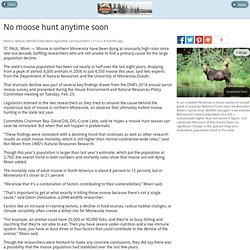
Wildlife managers now estimate Minnesota’s moose population at 4,350 — substantially higher than last winter’s figure - but cautioned February 14 that there’s been no significant change in the species’ long-term downward population trend in the state. Katie G. Nelson, Mesabi Daily News legislative correspondent | ST. Moose Die-Off Alarms Scientists. Twenty years ago, Minnesota had two geographically separate moose populations. One of them has virtually disappeared since the 1990s, declining to fewer than 100 from 4,000. The other population, in northeastern Minnesota, is dropping 25 percent a year and is now fewer than 3,000, down from 8,000. (The moose mortality rate used to be 8 percent to 12 percent a year.) As a result, wildlife officials have suspended all moose hunting. Here in Montana, moose hunting permits fell to 362 last year, from 769 in 1995. “Something’s changed,” said Nicholas DeCesare, a biologist with the Montana Department of Fish, Wildlife and Parks who is counting moose in this part of the state — one of numerous efforts across the continent to measure and explain the decline.
What exactly has changed remains a mystery. Winters have grown substantially shorter across much of the moose’s range. In Minnesota, the leading culprits are brain worms and liver flukes. Another theory is heat stress. Ontario slashes adult moose tags - Thunder Bay. Hunters in many areas of northern Ontario will have a harder time getting an adult moose tags for the upcoming moose-hunting season.
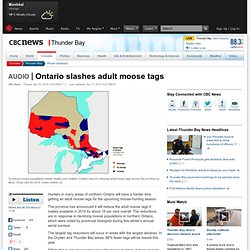
The province has announced it will reduce the adult moose tags it makes available in 2014 by about 18 per cent overall. The reductions are in response to declining moose populations in northern Ontario, which were noted by provincial biologists during this winter's annual aerial surveys. Moose management and research: Minnesota DNR. Click above to learn why a study lasting more than one year provides better information and potential answers.

Data collected during the first 12 months of the DNR's moose mortality project has given wildlife researchers an unprecedented view into the lives and deaths of Minnesota moose. In many instances, researchers know what killed a particular moose. From locations transmitted by high-tech GPS collars, researchers have watched an animal's movements in the days and hours leading up to its death. For a select group of moose, researchers were able to observe fluctuations in the animals' temperatures as injury, trauma or sickness occurred and life slipped away. As yet, there isn't enough data to answer with certainty why Minnesota's moose population has dropped 52 percent since 2010.
Data collected over the long-term is more informative and significant than information collected over the short-term. Science is a slow process. What's devastating the moose population in New England? Biologists document "drastic" decline in North Slope moose population; hunts canceled - Fairbanks Daily News-Miner: Outdoors. FAIRBANKS - The Alaska Department of Fish and Game is gutting moose hunting seasons on the North Slope this fall because of a "drastic" drop in the moose population.
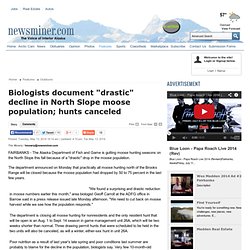
Researchers find some Minnesota moose moms abandon collared calves. The problem surfaced in 2013, during the first year of a major scientific study to find out why Northeastern Minnesota’s moose population, including calf survival, has been crashing.

The situation became so dire last month that officials nearly canceled the entire project. Finding the right method - Timberjay.com. After trial and error, researchers may have found a way to reduce calf abandonment REGIONAL— Wildlife researchers hoping to learn more about the causes behind the decline of moose in northeastern Minnesota were frustrated last year when a number of moose mothers abandoned their calves following the capture and GPS-collaring of their newborns.
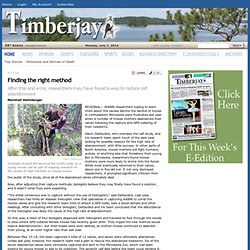
Glenn DelGiudice, who oversees the calf study, and his research team spent much of the past year looking for possible reasons for the high rate of abandonment, with little success. In other parts of North America, moose mothers will fight humans, wolves, or anything else that threatens their young. But in Minnesota, researchers found moose mothers were more likely to shrink into the forest. While most eventually returned to their calves, about one in five did not. Now, after adjusting their capture methods, biologists believe they may finally have found a solution, and it wasn’t what they were expecting. Moose researchers seek to avert abandonments.
Posted: Wednesday, June 11, 2014 7:16 am | Updated: 7:16 am, Wed Jun 11, 2014. Moose researchers seek to avert abandonments Associated Press | MINNEAPOLIS — Wildlife biologists trying to find answers about northeastern Minnesota's declining moose population were dismayed at how many mothers would abandon their calves shortly after researchers attached GPS tracking collars to the newborns.
They're now cautiously hopeful that they've found a solution. Department of Natural Resources researchers started attaching GPS collars to adult moose early last year. The collars gave them regular updates that made it possible to tell when the females were about to give birth. An online service is needed to view this article in its entirety. Need an account? But in Minnesota, seven of 31 mothers either never returned or came back but didn't stay long last spring.
"The advice we got was lose the helicopter," DelGiudice said Friday from his field station near Ely. What’s Killing Minnesota’s Moose?